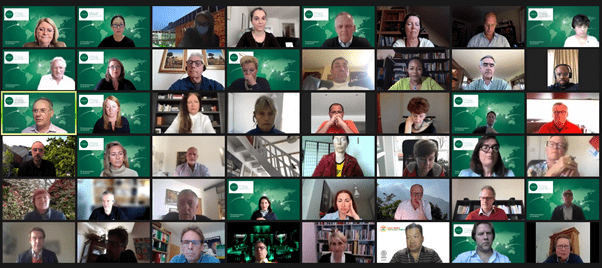Leading independent directors understand family board dynamics, build relationships with all board directors, and build a coalition of independent directors.
By Karen Loon IDP-C and IDN Board Member
Whilst family-owned firms are critical drivers of global business and growth, the role of their independent board directors is complex given the overlapping roles between family, ownership and business.
As a follow up to the session, Fit for Generations: How to Create & Lead a Family Business Board held in March 2021, on 26 April 2021, over 50 INSEAD Directors Network (“IDN”) members shared their international experiences of best practices in governance of successful family boards, focusing on their perspectives as independent board members.
The discussions were led by Martin Roll, Distinguished Fellow (Family Business) and Entrepreneur in Residence, INSEAD and Xavier Bedoret IDP-C, IDN Belgium Ambassador, NED and Advisor.
Liselotte Engstam IDP-C facilitated the event with support from Hagen Schweinitz IDP-C, both IDN board members.
The role and challenges of independent board members
Martin Roll set the scene, sharing his views on family-owned companies, highlighting their global power and influence.
“They’re interesting, because first of all, there are a lot of them. They’re very significant in terms of the global economy. They’re very significant in terms of entrepreneurship, and they also have a very big heart when it comes to impact. But at times they do need help, and this is where the family board members coming in” – Martin Roll.
After noting some of the challenges of wealth preservation of family-owned firms, Martin emphasised that that family business strategy depends on clear roles, responsibilities and guardrails between family, ownership and business.
The roles and responsibilities of their external directors are not easy, Martin said.
“We are external – we’re bringing a different point of view. We sit in the business. You are going to work with people in the families that you have around you, and you are also going to work with some of the key owners, and some of them being the business. You are in this triangle of a lot of different types of interests. As board members, we need to navigate that” – Martin Roll.
In addition to family, ownership and business, other areas which independent family board members may support with include family office and impact (which relates to sustainability and aligns to the higher purpose for the firm). Martin presented his Family Business Strategy model to help guide this process (Figure 1).
Resistance to changes in the investment strategy and impact investing often arise as new generations come into the business.
 Figure 1: Family Business Strategy (Copyright Martin Roll Company 2021)
Figure 1: Family Business Strategy (Copyright Martin Roll Company 2021)
Independent board members need to work with family firms to assist them in dealing with the dilemma of balancing the growth of their businesses with a long-term perspective and yet ensure family harmony and welfare. A key question is, how do they do that? Martin provided an overview – see Figure 2.
 Figure 2: Traits of effective board members (Copyright Martin Roll Company 2021)
Figure 2: Traits of effective board members (Copyright Martin Roll Company 2021)
Martin reminded members that sustainability is deeply embedded in many firms, which makes family firms interesting.
He highlighted a quote by André Hoffmann – “That’s what separates us from non-family-owned businesses. It’s the concept of sustainability which (I’m glad to say) is much in favour at the moment. And this sustainability is lived by the family.“
In order to be successful in their roles, Martin encouraged family board members to think of the following:
- Bring passion to family firms and build personal connections with key stakeholders across the business family system.
- Integrity is your key currency and never dilute its value. In the end, competence and experiences are the assets you contribute.
- Dare to renew! Renewal is the most important factor for business family success over the long term, so don’t hesitate to disrupt (with love)
Xavier Bedoret highlighted four challenges of independent directors: These are:
1. Combine the best of both worlds
Finding the right balance between the paradoxical tensions of tradition and modernity; family values and financial logics; stability and transformation is not easy. These can both be combined at the board or executive committee level.
2. Help develop the family spirit
A director needs to decide at what level they should be active – whether it is the family association, shareholder, director or manager level.
“Family spirit is the glue that prevents frustration and dissent” – Xavier Bedoret
3. Take the heat out of the decision process
The duality of “family” and “enterprise” can increase anxieties. Independent directors have a role to play to support family firms in this area.
“Emotions are a bias in relationships, and in family decision making” – Xavier Bedoret.
4. Engage young family members
Independent directors can play a role to support younger family members in their transition into more senior roles, given the family challenges of maintaining family values and managing power.
Three best practices of independent board directors of family-owned firms
For independent directors, working with family businesses is exceptionally complex but extremely rewarding. They often play a critical role in:
- Helping with communication (as often family members may not be on the same page);
- Supporting the transition of roles between senior generations and the next generation; and
- Assisting in managing conflicts such as finding a middle ground in situations of risk aversion.
Three best practices shared by IDN members included:
1. Understand dynamics of the family
The role of an independent director on a family-owned company can be much more complex than on a public listed board, given the chemistry.
Board members should understand why they were brought onto the board.
They also may need to prove themselves first as an expert to the board and the family to show what they can do before being trusted to assist them more broadly.
Board members may be expected to commit more time and be available much more than on other types of boards.
One suggestion was to “rush slowly” – understand time horizons, priorities, and the pace of change of the family shareholders. Family boards need to take their time to make the right discussions and decisions.
2. Build a coalition of independent directors
All independent directors should bring their own unique experience to the board. It is essential to ensure that independent directors are aligned and a force within the board.
3. Build relationships with all board members
This includes on a one-on-one basis. As not all board members may have the same knowledge of governance, help new board members succeed by arranging onboarding and an ongoing training programme to ensure they all have the necessary expertise to participate actively in board discussions.
To view Martin Roll’s slides, visit here.
IDN’s next webinar on Governance of Social Impact Ventures will be held on 11 June 2021.
INSEAD Directors Network (“IDN”) – An INSEAD Global Club of International Board Directors
Our Mission is to foster excellent Corporate Governance through networking, communication and self-improvement. IDN has 1,500 members from 80 countries, all Alumni from different INSEAD graduations as MBA, EMBA, GEMBA, and IDP-C. We meet in live IDN webinars and meet-ups arranged by our IDN Ambassadors based in 25 countries. Our IDN website holds valuable corporate governance knowledge in our IDN blog, and we share insights with our LinkedIn and Twitter followers. We highlight our member through quarterly sharing of their new board appointments, and once a year, we give out IDN Awards to prominent board accomplishments. We provide a peer-to-peer mentoring and board vacancy service, and we come together two times per year at the INSEAD Directors Forum arranged by ICGC. We also engage with ICGC on joint research.
INSEAD Corporate Governance Centre (“ICGC”)
Established in 2010, the INSEAD Corporate Governance Centre (ICGC) has been actively engaged in making a distinctive contribution to the knowledge and practice of corporate governance. The ICGC harnesses faculty expertise across multiple disciplines to teach and research on the challenges of boards of directors in an international context and to foster a global dialogue on governance issues with the ultimate goal to develop boards for high-performance governance. Visit ICGC website: https://www.insead.edu/centres/corporate-governance



